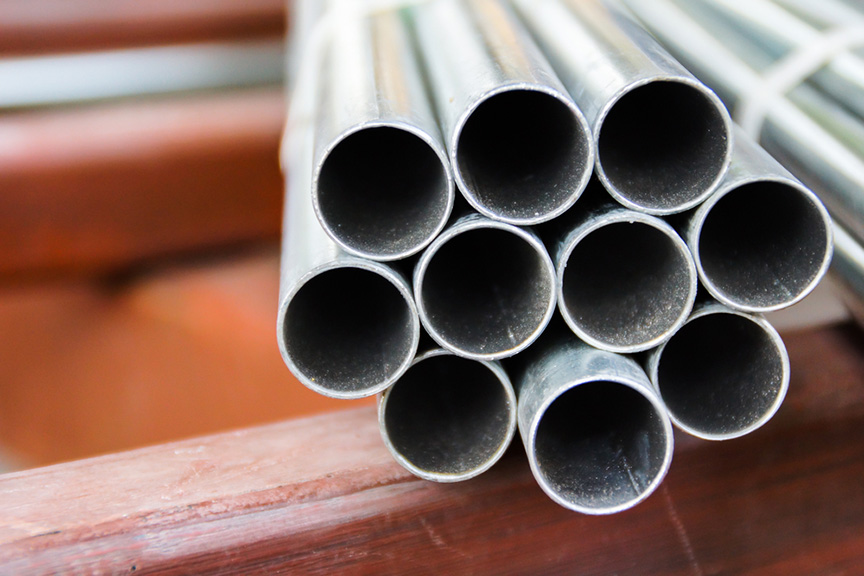
Carbon steel is a common type of steel. To define carbon steel in simple words, it is an alloy of iron and carbon. As its name suggests, carbon steel has higher carbon content with a lower melting point and greater durability as compared to stainless steel. Carbon steel is the most important group of engineering alloys and they account for the majority of the steel applications depending upon processes.
Carbon steel pipe is also called CS pipe. Carbon steel pipes are made of steel ingots or solid round steels through perforation into capillary tubes, which are then hot-rolled, cold-rolled or cold-drawn. Due to its strength and ability to withstand pressure, carbon steel pipes are used in a variety of heavy industries such as infrastructure, ships, stills, and fertilizer equipment. Carbon steel pipe plays an important role in my country’s steel pipe industry.
Carbon steel pipes are divided into two categories: hot-rolled and cold-rolled (drawn) steel pipes.
Hot-rolled carbon steel pipes are divided into general steel pipes, low and medium pressure boiler steel pipes, high pressure boiler steel pipes, alloy steel pipes, stainless steel pipes, petroleum cracking pipes, geological steel pipes and other steel pipes.
In addition to general steel pipes, low and medium pressure boiler steel pipes, high pressure boiler steel pipes, alloy steel pipes, stainless steel pipes, petroleum cracking pipes, and other steel pipes, cold-rolled (drawn) carbon steel pipes also include carbon thin-walled steel pipes, alloy thin-walled steel pipes, non- Rust thin-walled steel pipe, special-shaped steel pipe. The outer diameter of hot-rolled seamless pipes is generally greater than 32mm, and the wall thickness is 2.5-75mm. The outer diameter of cold-rolled seamless pipes can reach 6mm and the wall thickness can reach 0.25mm. The outer diameter of thin-walled pipes can reach 5mm and the wall thickness is less than 0.25mm. Cold rolling has higher dimensional accuracy than hot rolling.
General carbon steel pipe: It is made of high-quality carbon-structured steel such as 10, 20, 30, 35, and 45, low-alloy structural steel such as 16Mn and 5MnV, or alloy steel such as 40Cr, 30CrMnSi, 45Mn2, and 40MnB, which is hot-rolled or cold-rolled. Seamless pipes made of low carbon steel such as 10 and 20 are mainly used for fluid transportation pipelines. 45, 40Cr and other medium carbon steel seamless pipes are used to manufacture mechanical parts, such as the stressed parts of automobiles and tractors. Generally, carbon steel pipes are used to ensure the strength and flattening test. Hot-rolled steel pipes are delivered in hot-rolled or heat-treated state; cold-rolled steel pipes are delivered in heat-treated state.
Carbon steel can be further divided into low carbon steel, medium carbon steel and high carbon steel, mainly depending on the carbon content in the steel.
The carbon content is usually between 0.04% and 0.30%. Low carbon steel has good ductility and toughness, can be processed hot and cold, and is easy to weld. Commonly used low carbon steels include Q195, Q215, Q235, etc.
The carbon content is usually between 0.30% and 0.60%. Medium carbon steel has high strength and hardness, but low ductility and toughness. Commonly used medium carbon steels include 45# steel, 40Cr and so on.
The carbon content is usually between 0.60% and 2.00%. High carbon steel has high strength and hardness, but low ductility and toughness, and poor weldability. Commonly used high carbon steels include 65Mn, T8, T10, etc.
Carbon steel pipes can be divided into seamless steel pipes and welded steel pipes according to the production method. Seamless steel pipes are made by hot rolling or cold drawing, and have high strength and tightness. Welded steel pipe is made by rolling steel plate or steel strip into a cylindrical shape, and then connecting the weld seams by resistance welding, submerged arc welding and other methods.
Carbon steel has high strength, ductility and toughness at low cost and is used in heavy machinery to make heavy duty parts. The total amount of gold is generally less than 5%, which has greater impact toughness, and can obtain better mechanical properties through heat treatment. Casting low-alloy steel has better performance than carbon steel, which can reduce the quality of parts and improve service life.
Carbon steel piping provides safety and durability. It is an ideal material for structural applications due to its impact resistance and its imperceptibility to harsh environmental conditions such as stress or extreme weather.
The incredible strength of carbon steel means that carbon steel pipes can be made thinner and use less material while still being able to transport large volumes. This makes carbon steel piping a cost-effective material. Not only can the use be reduced, but the carbon steel can also be recycled, which is environmentally friendly and economical.
Carbon steel pipe is a versatile material due to its ease of fabrication. We can produce products in various thicknesses and sizes. It’s also easy to cut and bend to fit wherever needed. It also connects easily to fittings, valves and other plumbing fittings.
if you ever have a concern, question or comment please contact us and we will be more than happy to assist you to answer all your questions.
Address :
Jl. K.H. Zaenal Mustafa No. 17
Jatinegara Jakarta Timur 13350
Phone : 62 21 8561234 ( Hunting )
Fax : 62 21 8513109
E mail : info@fintubes.co.id